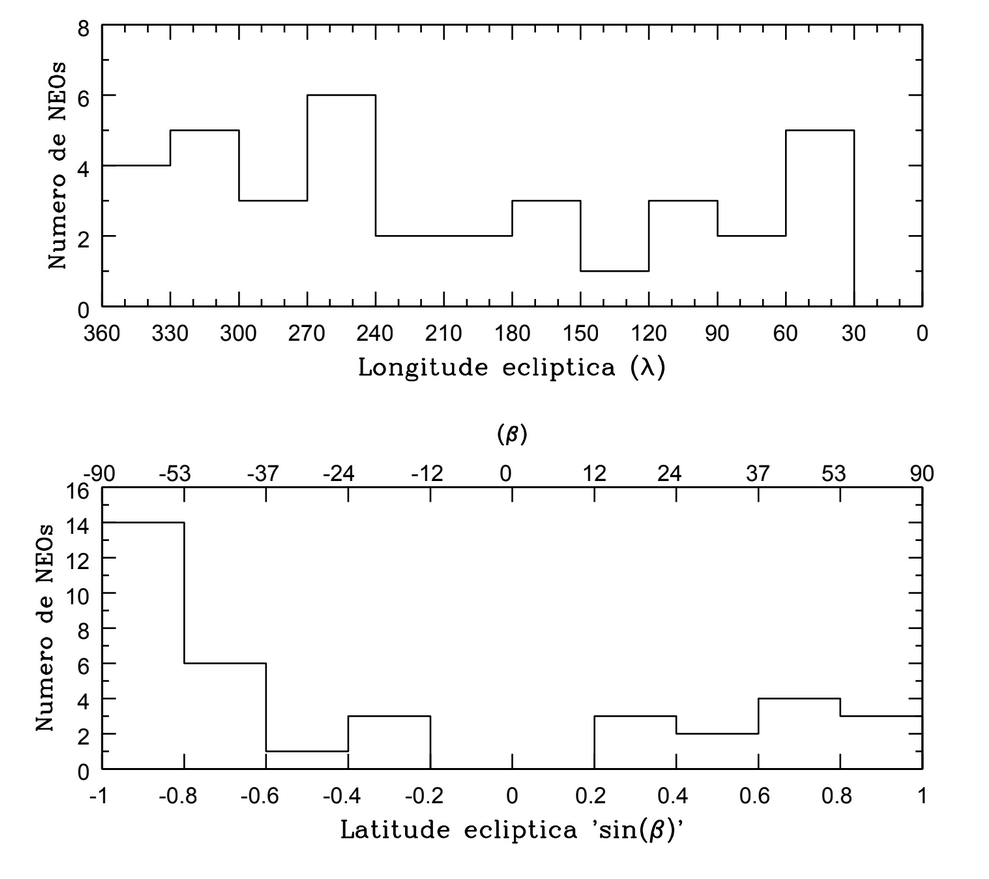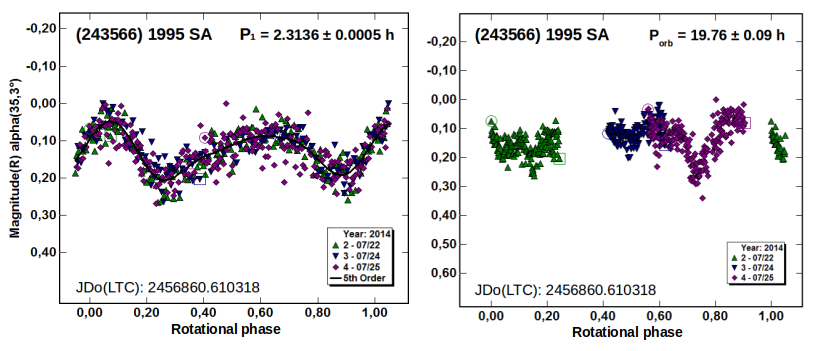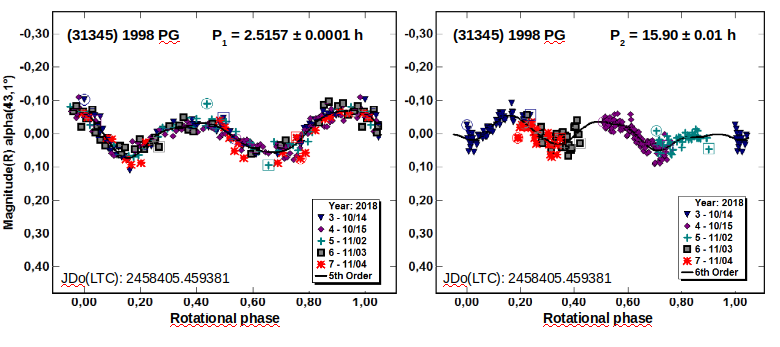Physical characterization of near-Earth objects from the IMPACTON project
- 1Observatório Nacional, R. Gal. José Cristino 77, 20921-400, Rio de Janeiro, Brazil (filipeastro@on.br)
- 2Instituto de Astrofísica de Canarias (IAC), C/Vía Láctea sn, 38205, La Laguna, Spain
- 3CONACYT - Instituto de Astronomía, Universidad Nacional Autónoma de México (IA-UNAM), AP 106, Ensenada 22800, BC, Mexico
Introduction
Asteroids lightcurves have been used extensively to derive many important physical characteristics such as rotational properties (rotational period and pole direction) and shape (Kaasalainen et al., 2004; Hanus et al., 2011; Durech et al., 2015), as well as to identify and characterize binary asteroids (Pravec et al., 2006). In addition, the rotational period and shape obtained from lightcurves can be used to estimate the internal cohesion strength required to prevent structural failure by centrifugal forces (e.g. Holsapple, 2007; Scheeres et al., 2010; Sánchez and Scheeres, 2014). Here, we will present some results of our extensive observational campaign for the physical characterization for a large sample of NEOs (Monteiro et al., 2017; Monteiro et al., 2018a,b; Rondón et al., 2019, 2020; Monteiro et al., 2020, 2021; Rondón et al., 2022; Monteiro et al., submitted).
Observations and data reduction
Photometric observations of about 150 NEOs were made at the Observatório Astronômico do Sertão de Itaparica (code Y28, OASI) of the IMPACTON project between 2012 and 2020. The images were acquired with the 1.0-m telescope using a 2048 x 2048 Apogee Alta U42 CCD camera. More details on the available instrumentation are given in Rondón et al., 2020. Lightcurve observations were carried out using sidereal tracking and an R-Johnson-Cousins filter. To obtain photometric spectra, observations were made using the g, r, i, z Sloan Digital Sky Survey (SDSS) filters. The science images were calibrated following the standard procedures, including bias, dark and flat-field images. The rotation periods were derived using a Fourier series analysis (Harris et al., 1989) while the spin direction and shape model were obtained by applying the lightcurve inversion method (Kaasalainen and Torppa, 2001; Kaasalainen et al., 2001). To investigate binary periods we used the "Dual Period Search" tool in MPO Canopus software. To obtain the photometric spectrum of some objetcs, we used standard field stars to calculate the zero-point of the night and, consequently, the calibrated magnitude of the asteroid.
Results
Reliable rotational periods and lightcurve amplitudes were determined for 88 NEOs (Monteiro et al. 2018a,b; Monteiro et al., submitted). For another 30 NEOs, only an estimate for the rotational period was obtained. The spin direction and shape model were obtained for about 15 NEOs. As an example, Fig. 1 shows the convex shape model for the NEO 2011 UW158, whose complete physical characterization was reported in Monteiro et al. (2020). These pole directions, along with those obtained from the DAMIT database (Durech et al. 2010), were used to analyze the pole distribution of the NEO population (Fig. 2). It is interesting to note that there appears to be a lack of poles toward the ecliptic plane. Clearly, a more representative sample is needed in order to derive robust conclusions.
Figure 1

Figure 2
About 20 fast rotators in our sample were analyzed for signs of satellites. For 8 of them, binarity signatures were found in their lightcurves (Monteiro et al., submitted). Fig. 3 shows the primary and secondary lightcurves of a suspected binary showing a possible mutual observed event. For the possible binaries (138846) 2000 VJ61 and (243566) 1995 SA, we derived the minimum relative size of the components of 0.26 and 0.37, respectively. NEOs 2007 EX, 2014 KD91 and 2015 FS332 showed a secondary lightcurve, but no signs of eclipse/occultation, indicating the rotation of a possible satellite.

Figure 3
We found binarity signatures for 3 confirmed binaries (Monteiro et al., submitted). The NEO (31345) 1998 PG showed a secondary lightcurve, but no clear mutual events, with a period of about 16 h. The primary and secondary lightcurves of this objects is shown in Fig. 4. Finally, we estimate the internal cohesion strength required to prevent the failure of seventeen binary candidates that rotate beyond the cohesionless bodies limit. We found a minimum cohesion ranging from 3 to 90 Pa, which is in agreement with the numerical simulations reported in the literature (Sánchez and Scheeres, 2014). This analysis is included in detail in our recently submitted paper (Monteiro et al., submitted).

Figure 4
Conclusions
We determined a large sample of reliable lightcurves with well defined rotation period and amplitude. We derived the rotational period for about 30 PHAs and for some of them we indicated their possible taxonomic types. The derived spin direction, along with those obtained from the DAMIT database, continue to show a majority of retrograde rotators, which is consistent with a preferential transport route from the inner main belt. In addition, we identified 8 possible binary NEOs, which showed binarity signatures in their lightcurves. Finally, we showed that some fast rotators in our sample require an internal cohesion strength of 3 to 100 Pa to avoid structural failure by centrifugal forces.
Acknowledgements
F.M. thanks the financial support given by FAPERJ (E-26/201.877/2020). E.R., M.S., P.A, W.P., W.M., H.M. and T.C. would like to thank CAPES and CNPq for supporting this work through diverse fellowships. Support by CNPq (310964/2020-2) and FAPERJ (E-26/202.841/2017 and E-26/201.001/2021) is acknowledged by D.L. The authors are grateful to the IMPACTON team and, in particular, to R. Souza and A. Santiago for the technical support.
References
Durech J. et al. (2010), A&A, 513, A46.
Durech, J.,et al., 2015. Asteroids IV, pages 183-202.
Harris A. W., et al., 1989, Icarus, 77, 171.
Holsapple, K. A. (2007). Icarus, 187(2):500-509.
Kaasalainen, M. and Torppa, J. (2001). Icarus, 153:24-36.
Kaasalainen, M., Torppa, J., and Muinonen, K., 2001. Icarus, 153:37-51.
Kaasalainen, M., et al., 2004. Icarus, 167(1):178-196.
Margot J.L., et al., 2015. Asteroids IV. Pp 355–374.
Monteiro, F., et al., 2017. Minor Planet Bulletin 44, 20-22.
Monteiro, F., et al., 2018a. Minor Planet Bulletin 45, 221-224.
Monteiro, F., et al., 2018b. Planet. Space Sci. 164, 54-74.
Monteiro, F., et al., 2020. MNRAS, 495, 3990-4005.
Monteiro, F., et al., 2021. MNRAS 507, 5403–5414.
Perna, D., et al., 2016. AJ, 151(1):11.
Pravec, P., et al., 2006, icarus, 181, 63.
Rondón, E., et al., 2019. MNRAS, 484:2499–2513.
Rondón, E., et al., 2020. PASP, 132(1012):065001
Rondón, E., et al., 2022. Icarus 372, 114723.
Sánchez, P. and Scheeres, D. J., 2014. Meteoritics and Planetary Science, 49(5):788-811.
Scheeres, D. J., et al., 2010. Icarus, 210(2):968-984.
How to cite: Monteiro, F., Lazzaro, D., Rondón, E., Evangelista-Santana, M., Arcoverde, P., Pereira, W., Mesquita, W., Michimani, J., Medeiros, H., Corrêa, T., Silva-Cabrera, J., and Rodrigues, T.: Physical characterization of near-Earth objects from the IMPACTON project, Europlanet Science Congress 2022, Granada, Spain, 18–23 Sep 2022, EPSC2022-767, https://doi.org/10.5194/epsc2022-767, 2022.

